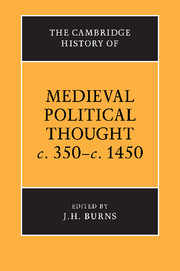4 - Byzantine political thought
from II - Byzantium
Published online by Cambridge University Press: 28 March 2008
Summary
The Byzantine Empire, or the Byzantinisation of the Roman Empire, began with the conversion to Christianity of Constantine and his foundation of Constantinople on the site of the ancient Greek city of Byzantium. At once the main elements of Byzantine political thought are gathered together in one sentence. For Byzantine civilisation was an amalgam of three ingredients: Greek, Roman and Christian. Its political theory derived from the first two of those ingredients, which were tempered to accommodate the third. Its originators and its first apologists were the first Christian Emperor, Constantine, and the first historian of the Christian Church, Eusebius of Caesarea. The sincerity of Constantine's conversion has often been questioned, but his own writings leave little room for doubt that he saw himself as the servant and representative on earth of the Christian God. None of the Christians in his empire thought otherwise. The majority of his subjects were still pagan. They were shocked and offended that their emperor had seen fit to embrace a minority religion. But their pagan theorists, such as Themistius, were able to mitigate the shock by appealing to the Hellenistic theories of kingship. Here was common ground where pagan and Christian could meet on the subject of monarchy.
Themistius regarded earthly monarchy as a copy of the kingship of Zeus, the supreme emperor (basileus). The kingdom of this world would be a reflection, a replica of that higher model. The king must possess and display a whole catalogue of virtues. Such notions can be traced back to the political theorists of Greek antiquity.
- Type
- Chapter
- Information
- Publisher: Cambridge University PressPrint publication year: 1988
References
- 9
- Cited by



